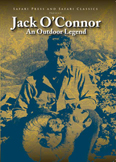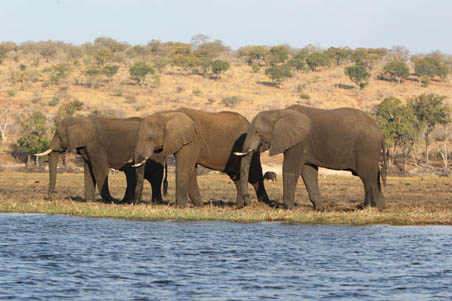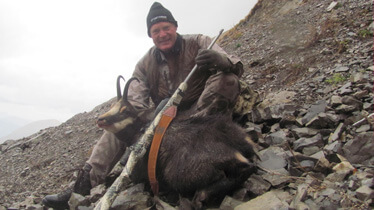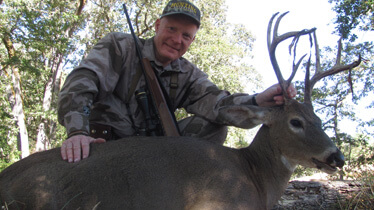New bullet designs and construction have given new life and new versatility to the venerable .45-70 Government.
While big bore lever-actions have long been a favorite of deep woods whitetail hunters, 21st Century reloading components and ammunition have made the .45-70 much more versatile and easily capable of taking moose and elk out to 250 yards.
As a young man growing up in British Columbia in the 1960s, I had little exposure to lever guns or the cartridges associated with them. If I did see someone with a lever-action it was either an old Savage Model 99 in .308 Winchester or the then-racy Winchester Model 88 in .284 Winchester. Bolt-actions were the norm and young big-game hunters usually started out with a budget-priced “sporterized” Lee Enfield in .303 British and aspired to eventually move up to a new Parker Hale bolt-action chambered for .30-06.
The old .45-70 Government was something I had read about, but had never actually seen, and it wasn’t until the mid-1970s that I finally saw one in use for the first time. As was the general consensus of pretty much anything you read on the cartridge in those days, I believed the .45-70 to be a cartridge for close-range work, shooting a big, heavy bullet with the trajectory of a brick.
I was elk hunting in the Kootenay region of southeastern British Columbia and had located a small meadow with lots of elk sign. Wanting to get a better handle on when the elk were coming and going, I found a comfortable spot to glass and settled in for the evening vigil. About fifteen minutes before the end of legal shooting light a few cows and calves began to filter out of the spruce trees on the far side of the meadow and were soon followed by a raghorn bull.
As it turned out, I was not the only one who had noticed the elk sign. While watching the young bull through my binocular, I saw him stagger from the impact of a bullet as it slammed into his right shoulder, and simultaneously heard a loud report. The bull stumbled forward a few yards, fighting to stay on his feet, and piled up. Moments later I spotted the lone hunter as he exited the forest edge, walking slowly towards the downed elk.
My elk hunt was definitely over, so I stood up, whistled to get the hunter’s attention, and then walked over to meet him at the elk. As I approached the hunter and the downed elk, my focus shifted from the bull to his rifle, as it was not the type of firearm you usually saw being carried by an elk hunter in the Canadian Rockies. Turned out the lucky hunter was carrying a Sharps reproduction chambered in .45-70 Government and he had made a 250-yard shot with open sights, using a heavy cast bullet. Needless to say, I was impressed by both his shooting and the real-world performance of the rifle and cartridge on a big-game animal that has a bit of a reputation for being rather tenacious.
Designed for use in the Model 1873 “Trapdoor” Springfield, the .45-70 was originally called the .45-70-405, which stood for the cartridge being .45-caliber, using 70 grains of black powder behind a 405-grain cast lead bullet. This load produced a velocity of about 1,300 fps in the long-barrel version of the Springfield that was carried by the infantry. A reduced load with 55 grains of black powder, with a muzzle velocity of 1,100 fps, was used in the shorter-barrel carbines carried by the cavalry.
As is usually the case with cartridges designed for military use, many thousands of veterans developed an appreciation for the .45-70 and it quickly gained popularity with sportsmen in the United States. In order to meet the new demand for rifles in this cartridge, manufacturers quickly began producing rifles chambered for the .45-70, rifles which helped define an era, such as the Sharps 1874, Winchester’s Model 1885 High Wall and Model 1886 lever-action, and the Remington Rolling Block. These were followed a few years later by Marlin releasing the lever-action model M1895.
Even when using the simple, paper-patched cast bullets available at the time, the .45-70 was an extremely potent round and gained a reputation for being very effective on large, tough game such as the plains bison and grizzly bear. Through the 1880s and 1890s, the .45-70 was arguably the most popular big-game cartridge in the USA. Initially the commercial designation for the cartridge was .45 Government, but it was later changed to .45-70 U.S Government and eventually shortened to .45-70 Government or .45-70 Govt.
With the development of smokeless powder, “high velocity” sporting cartridges arrived in the 1890s. In the early stages of their development the smaller caliber smokeless cartridges encountered many problems with bullet design—increased velocity caused some to fall apart on impact and failed to give adequate penetration. Others, beefed up in an attempt to counteract that problem, penciled through game without creating a large enough wound channel.
Eventually, however, bullet designs improved and many of the performance issues were overcome. The twentieth century’s newer generation of hunters embraced the high-velocity smokeless cartridges and the practical implications of a flatter trajectory. The writing was on the wall, so to speak, and the popularity of the old big-bore blackpowder cartridges began a steady downhill slide. Marlin discontinued the M1895 in 1917 and Winchester discontinued production of the 1886 rifle in .45-70 in 1935.
For about four decades the .45-70 teetered on the edge of extinction, kept alive mostly by a few handloaders and blackpowder enthusiasts. Too good to die, the .45-70 finally got a new lease on life during the 1970s. Marlin began manufacturing the new model 1895; Ruger offered the chambering in their classy No. 1 single-shot rifles, and Shiloh Products Inc. of New York began producing Sharps rifle reproductions.
The reintroduction of Marlin’s new model 1895 in .45-70 drew a lot of attention from bear hunters and guides, who immediately recognized the benefits of this fast handling powerhouse. Not too long after my encounter with the Sharps-packing elk hunter I had my second encounter with the .45-70.
I was guiding fall coastal grizzly hunts in British Columbia. We hunted the big bears by slowly wading up shallow tributaries of coastal rivers, where the bears had gathered in large numbers to feast on the fall salmon runs. The floatplane arrived with supplies, our two bear hunters, and their gear. Once the hunters were settled in at camp, we put up a target to check their rifles and I found out that the hunter I would be guiding was packing a new Marlin M1895 in .45-70. This generated a lot of discussion, as most clients at that time were carrying shiny new Weatherby Mark Vs or Remington Model 700s chambered in one of the popular fast-stepping magnums.
As it turned out, the .45-70 proved to be very much up to the task at hand. The hunter killed a big boar, dropping him in his tracks at forty yards and then quickly worked the lever and put in an insurance round. It was over rapidly and it gave me a new appreciation for both lever guns and the centenarian cartridge.
With .45-70 ammunition, the strengths and weaknesses of the various rifle actions are used to split reloading data for the .45-70 into three categories. The weakest are the Trapdoor Springfields and early lever-actions and single-shots. The next category is the higher-pressure loads for the modern lever action rifles like the post-1972 Marlin M1895. The third category and highest-pressure loads are those for the Ruger No.1 single-shot rifle or custom bolt-action rifles built on modern actions.
All .45-70 ammunition produced by the major U.S manufacturers is loaded to very safe pressures for use in antique arms. To some extent, this precaution has limited the popularity of the .45-70, but as many older firearms are still in circulation and in use, low-pressure factory ammunition is an unfortunate necessity so manufacturers can protect themselves against litigation.
Maximum pressures in factory loads are typically limited to 28,000 CUP or 28,000 PSI so that they will work safely in all categories, and in truth, most factory loads do not come anywhere close to that pressure. Reloading guides usually suggest maximum working pressures of 40,000 CUP for the second category of higher-pressure loads for the Marlin M1895 lever-action, and 50,000 CUP for ammunition used in the Ruger No. 1 and custom bolt-actions.
Remington, Winchester, and Federal all produce loads for 300-grain jacketed bullets with velocities between 1,600 and 1,800 fps in 22- to 24-inch barrels. In the new Marlin M1895 category, 300-grain bullets can be safely driven at 2,200 to 2,300 fps and in the Ruger No.1 category at 2,400 to 2,500 fps. Needless to say, there is a marked difference in the trajectory with the significant difference in velocities.
Many question whether there is a significant enough difference in the pressures that can be handled by the robust Marlin action and the Ruger No. 1 to warrant three distinct load categories, believing that the number of pressure-related categories for reloading could be simplified to just two: low and high velocity. With that in mind, I have noticed that several publications have, in fact, started to do just that.
With traditional cup-and-core style bullets, the weights that have usually been offered in factory ammunition are 300, 350, 400, and 405 grains. More recently Hornady introduced the 325-grain FTX. The lighter bullets were intended for deer-size game and the heavier bullets for larger game, such as elk, moose, and bears.
As mentioned earlier, factory loads have always been rather anemic due to potential liability issues. An example of this is Remington’s load with its 405-grain soft point. The advertised velocity was just over 1,300 fps, but in reality, usually chronographed at about 1,200 fps. Even the newer and highly touted Hornady LeveRevolution ammunition with its 325-grain FTX rubber-tipped bullet chronographed at just over 1,900 fps in my Marlin 1895 Classic.
Getting the true potential out of the .45-70 has traditionally only been possible for handloaders, but there are a couple of smaller ammunition manufacturers that are producing ammunition that increases the old cartridge’s performance to a whole new level. One of these companies is Buffalo Bore Ammunition of Salmon, Idaho. They offer a load with a 405-grain jacketed bullet at 2,000 fps and a 300-grain load at 2,350 fps.
The many new mono-metal bullets being offered by the bullet manufacturers has also created additional options and improved downrange performance for the .45-70. Mono-metal bullets are long for their weight when compared to conventional bullets, with increased sectional density and in some cases higher ballistic coefficient. The expected performance of mono-metal bullets in the field is much different than that of conventional jacketed bullets. They typically provide a wider wound channel than conventional heavy-for-caliber .45-70 bullets as well as superior penetration.
Barnes offers handloaders its TSX bullets in 250, 300, and 350 grains. Buffalo Bore offers its ammunition in two different loads with Barnes TSX bullets, the 300-grain TSX-FN at 2,350 fps, and the 350-grain TSX-FN at 2,150 fps.
Recently Hornady introduced a 250-grain mono-metal bullet with a flexible rubber tip called the MonoFlex and are offering it in their LeveRevolution ammunition.
Another company that is now offering a line-up of exciting mono-metal bullets designed with the .45-70 in mind is Cutting Edge Bullets of Drifting, Pennsylvania. Their solid brass, precision machined, .458 caliber Lever+Raptor bullets come in 250, 295, and 370 grains. These bullets are designed to create a massive wound channel and provide maximum penetration.
Those who prefer to use heavy-jacketed bullets in the .45-70 also have many options these days from a number of premium quality bullet manufacturers such as Hawk, North Fork, and Swift. Commercial cast lead bullets are also available from several companies in a variety of weights and bullet shapes, and, of course, Lee, RCBS, and Lyman offer all the equipment necessary for those who would prefer to roll their own.
Garret Cartridges of Texas is a custom ammunition manufacturer that offers .45-70 loads with specially designed hard cast bullets. Their Hammerhead bullets have a wide meplat and are available in their ammunition in weights from 420 to 540 grains. These bullets provide hunters using their .45-70s on large, heavy game with outstanding penetration.
The .45-70 has been typecast for many years as a cartridge that shoots big, heavy bullets at very modest velocities and is therefore a cartridge only suitable for close-range hunting in heavy cover, despite the fact that it was originally designed and intended to be used by the U.S. military at ranges up to 1,000 yards. Despite untold improvements in reloading components over the years that have breathed new life into many old cartridges, the .45-70’s inherent potential has been deliberately suppressed by manufacturers of commercial ammunition due to liability issues.
New bullet designs and construction offer significant improvements in the .45-70’s downrange performance. While it has only been possible for handloaders to tap into these improvements in the past, custom ammunition companies are now offering ammunition that capitalizes on the newly available components and the .45-70’s inherent accuracy, extending its useful range by at least 50 yards.
In the not-too-distant past the .45-70 was considered to be at its best inside 150 yards, with 175 to 200 yards being about as far as a prudent hunter should consider shooting. With a bit of practice and the right ammunition, there is no reason why the .45-70 cannot now be used effectively out to 250 yards. And that makes this grand old cartridge viable for the majority of hunters, as most big-game animals are taken inside of 200 yards year in and year out.
The .45-70 Government is much more versatile than many realize, and with the right bullets it is capable of cleanly taking the biggest game animals in North America, including the big bears, moose, and bison. It has been used many times by hunters for plains game in Africa and has successfully taken all of the Big Five. Few cartridges have survived and maintained their usefulness as long as the .45-70.
This past fall I had the pleasure of hosting a hunter from southern California on a black bear hunt. Aaron’s rifle of choice was a Shiloh Sharps in .45-70, shooting a heavy 512-grain hard cast bullet with a .3-inch meplat that he had cast himself with a Lyman custom mold.
It was definitely a case of déjà vu. Forty years had gone by since I had watched that young bull elk get hammered by a heavy cast bullet from a Sharps replica in .45-70.
Just two days into his bear hunt, at last light, Aaron squeezed the trigger on his Sharps and sent that heavy cast bullet on its way. The bullet smashed a shoulder and traversed the chest cavity of the big bruin, which then ran a few yards and collapsed. Some things just work.
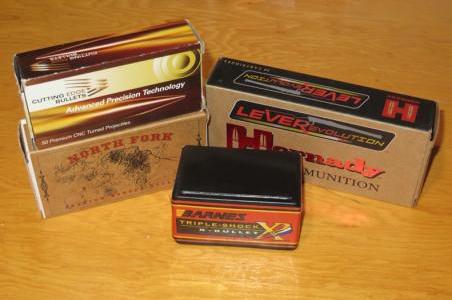
In recent years bullet and ammunition manufacturers have introduced premium bullets and ammunition that bring new life to the .45-70. New lighter mono-metal bullets and increased ballistic coefficients offer superior downrange performance.
Leave a Comment


